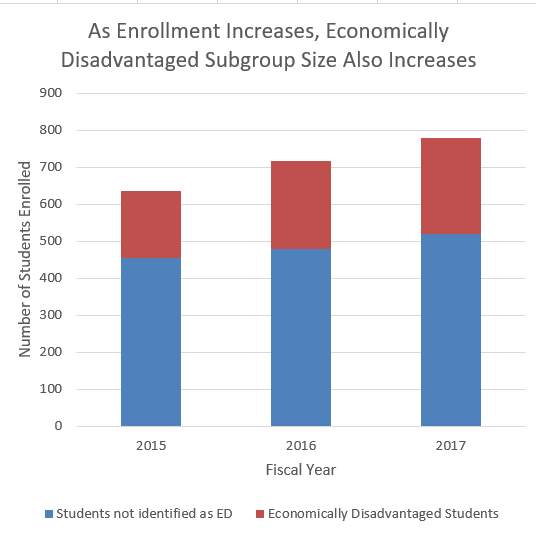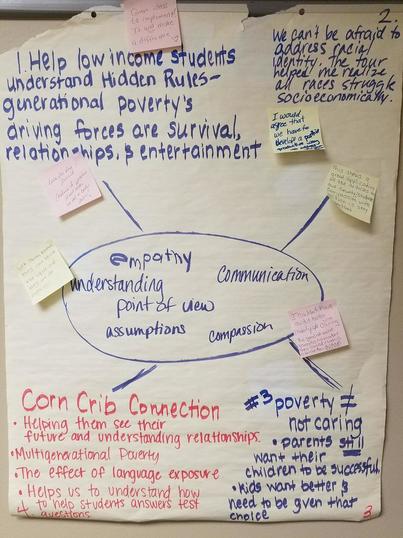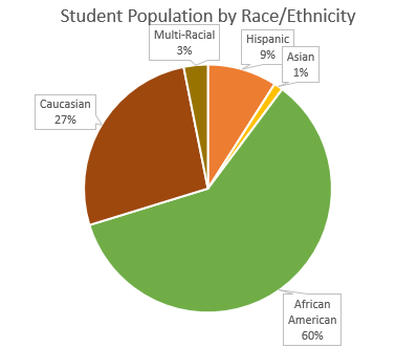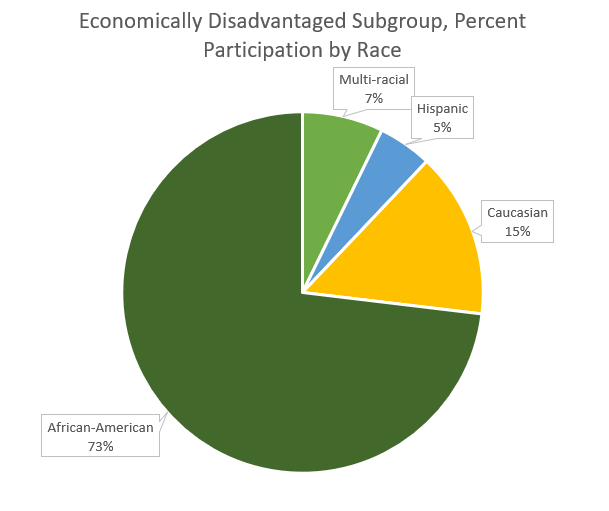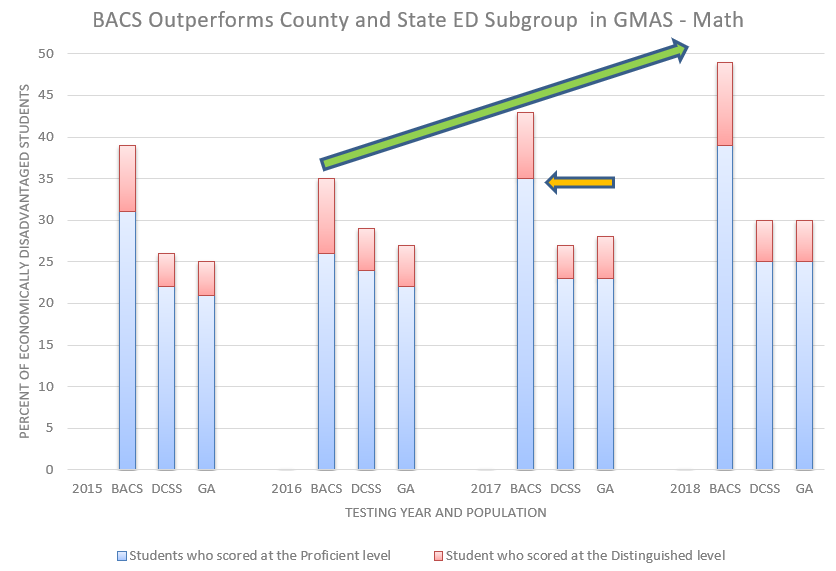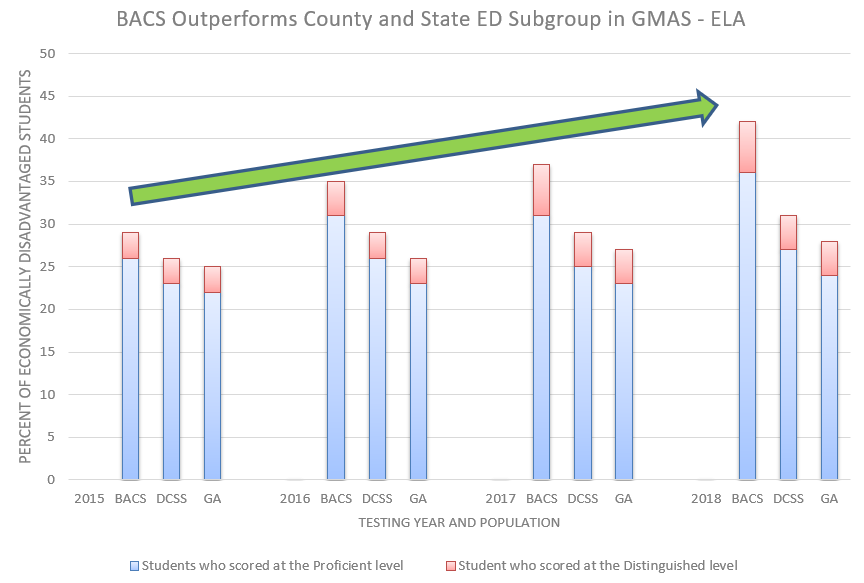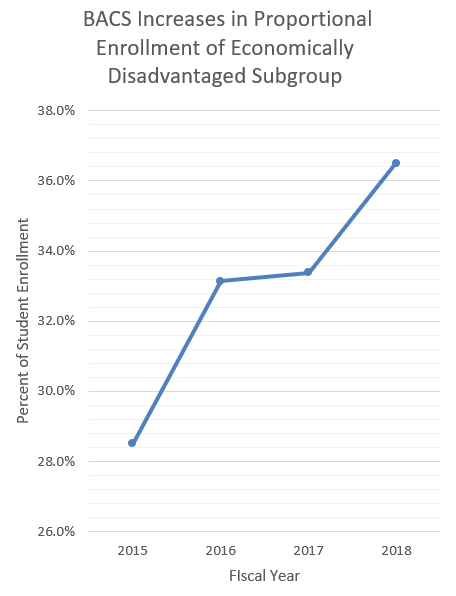Claim 2
Students in the Economically Disadvantaged subgroup consistently outperform district
and state averages in reading and math achievement.
Beating the Odds
|
Equity is at the heart of the charter school movement. Despite our desire to serve a diverse population from all areas of our county, Brighten did not initially attract a large Economically Disadvantaged (ED) subgroup, and for a number of years less than 10% of our enrolled students were identified as ED. Over the last 5 years Brighten has seen a substantial increase in the size of our Economically Disadvantaged subgroup. With 37% of our 2018 enrolled students being identified as Economically Disadvantaged, we have tripled this subgroup over time. Commensurate with research correlating poverty rates with achievement, many of these students come to us with academic deficits in skills, knowledge, and experiences. |
|
Brighten’s Governing Board, leadership team, and staff have not shied away from shifting our practices to ensure that as our school grows and its population’s needs change, we must adapt. Building the Work Plan annually with the support of our EL Designer has guided professional development and refocused our commitment to achievement and inclusion. With EL practices that not only ensure mastery of foundational skills, but also ensure access to higher levels of learning, all students, irrespective of socioeconomic status can in short, “beat the odds.”
|
Knowing Our Students
|
EL's Core Practice 24 has guided us to actively learn about our community members and their experiences with schooling. We have invested ourselves in understanding the students we serve and their families. Touring the neighborhoods across our district, our staff came to better understand why children may come to school hungry or without the supplies they need. We focused our professional development on understanding cultural similarities and differences in students. Our staff hosted parent support classes and committed efforts to building bridges between families and the school.
|
|
As we monitor data to identify patterns of inequity through Core Practice 33, we analyze subgroup composition in addition to subgroup performance. Note that the composition of our Economically Disadvantaged subgroup mirrors our school enrollment closely and cuts across all races. As teachers complete ongoing analysis through data protocols, they are careful to examine unconscious biases and to design systems that reduce the effect of these biases on historically underserved populations.
|
Supporting Our Students

As we have fully engulfed ourselves in EL Education’s approach to learning, we have found that we are better able to meet the needs of all students, even those who typically find the most challenge with mastering knowledge and skills. Protocols, modules, expeditions, and Crew support key foundational skills, build collaboration and equity among learners, and build relationships of trust among staff and students. All students, regardless of socio-economic status, have the tools needed to access higher level learning and to find success. We are proud to quantitatively demonstrate that Brighten Academy students consistently performed above our district, state, and national norms. More than just quantitatively, we are proud to share high quality work demonstrating deep learning, that qualitatively, shows success for all students, and in particular, our students in the Economically Disadvantaged subgroup.
Growing as a School
In 2014, our EL journey began just before our large enrollment growth, we had 518 students. Currently our enrollment is 801 students, with an average growth of 100 students per year. Concurrent with enrollment growth, our diversity has also increased significantly through our EL partnership. In 2014, 50% of students were considered minority, and by 2017, 70% of students identify as minority. This rapid growth provided our school an amazing opportunity to reach many of the historically underserved students in our county.
|
From 2015 to 2016, Brighten Academy observed a decrease in Math performance with this subgroup. With evidence-based strategic-improvement in mind (Core Practice 33), we designed a long-term action plan to proactively ensure all students meet/exceed the standards. Through an intense focus on math writing, and the support of Core Practices 14-15, we experienced huge growth the following years (green arrow), and our levels of proficient-rated learners alone far exceeded county and state (orange arrow).
|
Brighten Academy has observed a steady growth (green arrow) within ELA scores from the Economically Disadvantaged subgroup. Our students have shown remarkable growth in performance, across all subgroups. Our teachers have implemented the EL Modules (Core Practices 11 and 13) with fidelity and our scores support the rigor and challenge they present. We anticipate many years of this extended growth trend.
|
|
The proportionate size of the Economically Disadvantaged subgroup at Brighten Academy continues to be slightly lower than the proportionate size of the Economically Disadvantaged subgroup in Douglas County. Though Brighten Academy increased enrollment drastically in 2015, all students demonstrated quality performance that continued to exceed that of Douglas County and the State of Georgia, as shown in Claim 1. With the support of EL Education and our Crew spirit, we have developed a deep respect for others, regardless of socioeconomic status, which has helped us as our Economically Disadvantaged subgroup has grown. Increased diversity promoted learning opportunities to strengthen Crew, build relationships school-wide, and differentiate teaching strategies. |
Looking Back...
When Brighten decided to expand, we were fearful that the growth would present challenges in our achievement and school culture. This put us in problem-solving mode, searching for an educational model to partner with to address our concerns. This led us to EL Education and the shared conviction that Mastery of Knowledge and Skills, Character, and High Quality Work are of equal importance.
Looking Forward...
We have grown considerably in the last few years, and with this growth we have had opportunities to overcome challenges and enrich our school culture. Tripling our Economically Disadvantaged subgroup has led our school to make improvements in our instruction and culture, with widespread benefits for all students. We are now poised to capitalize on our students' varied assets, as we continue our work in Differentiating Instruction (Core Practice 19) and Creating a Culture of Engagement and Achievement (Core Practice 27).
